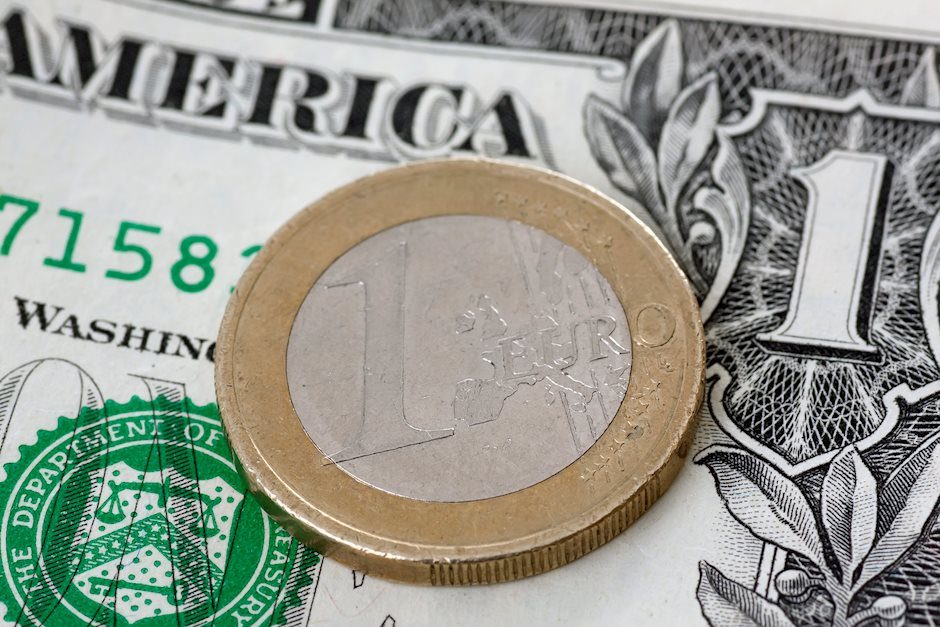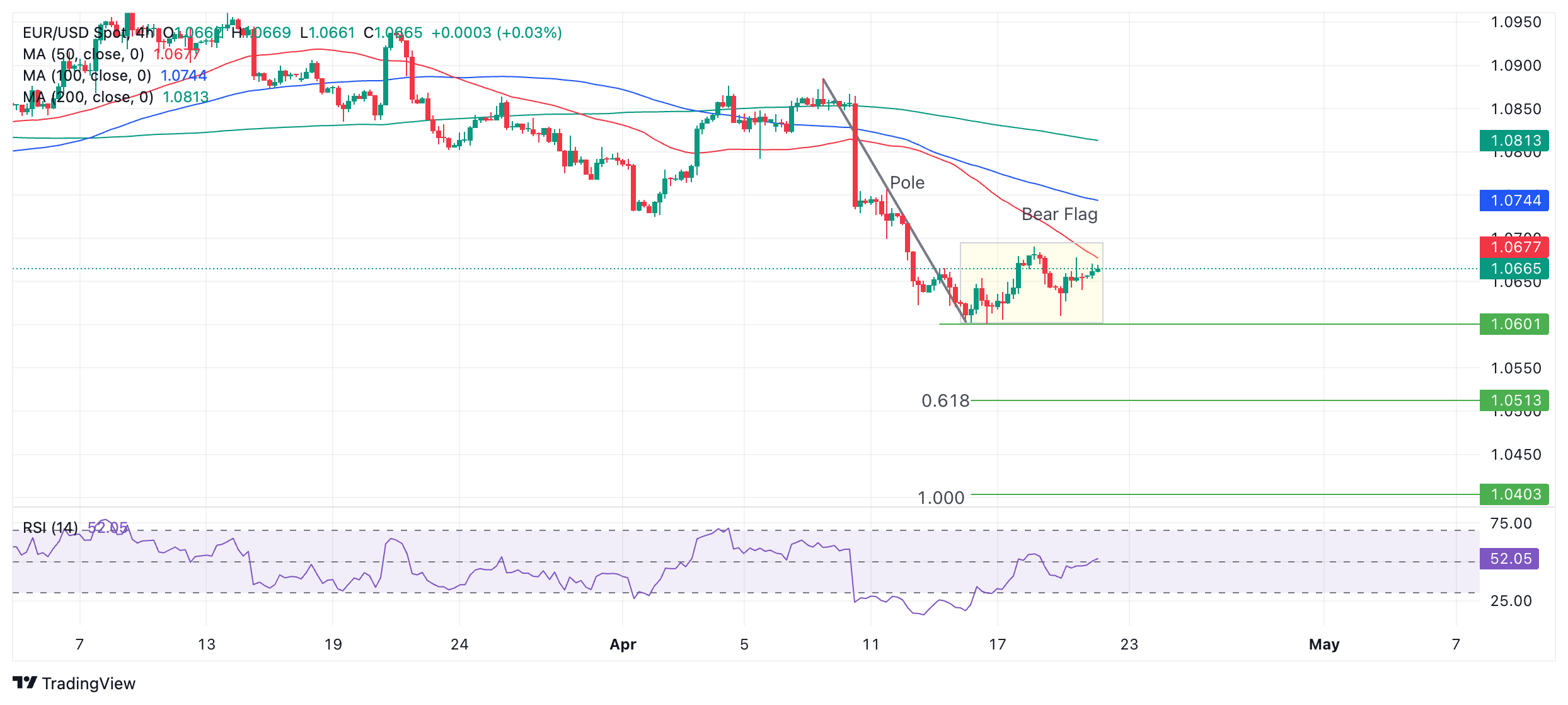Created
: 2024.04.22














![]() 2024.04.22 16:30
2024.04.22 16:30
EUR/USD continues to trade within a contained box-like range, up a marginal tenth of a percentage point in the 1.0660s on Monday.
A lack of escalation in the Israel-Iran conflict has led to an unwinding in geopolitical risk, which has reduced demand for the safe-haven US Dollar and provided EUR/USD with a slight lift.
Most analysts are bearish EUR/USD, however, because of a diverging outlook for future path of interest rates - a key FX driver - in the US as compared to Europe.
EUR/USD is expected to continue weakening by many experts because of the comparative outlook for interest rates, which drive capital flows. Interest rates are expected to remain higher in the US compared to Europe, making it a more attractive place to store capital, thereby increasing inflows and Dollar-demand.
On the US side, stubbornly high inflation, a robust jobs market and strong economic growth are all reasons to keep interest rates at their current level (5.25%-5.50%).
"It is hard to find any reasons to bet against the Dollar," said Michael Pfister, FX Analyst at Commerzbank in an interview with Bloomberg News on Monday. "We have seen an appreciation in the Greenback over the last two weeks on the back of an inflation surprise. On top of that we have a strong growth advantage and a very hawkish Fed," added the analyst.
Pfister sees the Federal Reserve (Fed) not making a first rate cut until December, which is a big change from expectations earlier this year, when the consensus was that the Fed would make its first interest rate cut in June. The Fed themselves, in their last Summary of Economic Projections (SEP), forecast about three 0.25% cuts over the whole of 2024.
This contrasts with Europe, where disinflation has been stronger and economic activity weaker. Additionally, officials at the European Central Bank (ECB) which sets base lending rates for the entire region (currently at 4.5%), appear more united in advocating for a cut in June, compared to their colleagues across the Atlantic.
"To be honest, I am often surprised that the Euro is not much weaker," says Ulrich Leuchtmann, Head of FX and Commodity Research also at Commerzbank in a note on Monday.
"Over the weekend, news services reported in advance on an interview with François Villeroy de Galhau, Governor of the Banque de France. According to these reports, Villeroy confirmed the ECB Governing Council's intention to cut interest rates at its meeting on June 6," adds Leuchtmann.
How low could the Euro go? When asked whether he saw EUR/USD falling all the way to parity, Pfister replied "Not quite as low as parity but we see EUR/USD probably falling to 1.0400."
EUR/USD has been yo-yoing in a rectangular range since it bottomed at 1.0601 on April 16. The range is roughly at the level of the 100-week Simple Moving Average (SMA).
Taken together with the steep decline that preceded it, the rectangle resembles an almost-complete Bear Flag pattern on the 4-hour chart below.

A break below the 1.0601 April 16 low would signal a probable activation of the Bear Flag and the start of a deep decline. Technical analysts forecast the move out of a Bear Flag as equal to the length of the "pole" or the steep decline preceding the box-like formation of the flag square, or a Fibonacci ratio of the pole.
The Fibonacci 0.618 ratio of the pole extrapolated lower provides the most reliable conservative target. This gives a price objective at 1.0503. After that, the next concrete target is at 1.0446 - the October 2023 low. A fall of equal length to the pole would take the exchange rate all the way down to 1.0403.
The Relative Strength Index (RSI) has exited oversold conditions, indicating renewed potential for more downside.
For bulls, resistance at around 1.0700 will need to be overcome to have any hope of recovery. After that, the April 2 swing low at 1.0725 provides the next upside target followed by 1.0800, where a cluster of major Moving Averages coils.
The Euro is the currency for the 20 European Union countries that belong to the Eurozone. It is the second most heavily traded currency in the world behind the US Dollar. In 2022, it accounted for 31% of all foreign exchange transactions, with an average daily turnover of over $2.2 trillion a day. EUR/USD is the most heavily traded currency pair in the world, accounting for an estimated 30% off all transactions, followed by EUR/JPY (4%), EUR/GBP (3%) and EUR/AUD (2%).
The European Central Bank (ECB) in Frankfurt, Germany, is the reserve bank for the Eurozone. The ECB sets interest rates and manages monetary policy. The ECB's primary mandate is to maintain price stability, which means either controlling inflation or stimulating growth. Its primary tool is the raising or lowering of interest rates. Relatively high interest rates - or the expectation of higher rates - will usually benefit the Euro and vice versa. The ECB Governing Council makes monetary policy decisions at meetings held eight times a year. Decisions are made by heads of the Eurozone national banks and six permanent members, including the President of the ECB, Christine Lagarde.
Eurozone inflation data, measured by the Harmonized Index of Consumer Prices (HICP), is an important econometric for the Euro. If inflation rises more than expected, especially if above the ECB's 2% target, it obliges the ECB to raise interest rates to bring it back under control. Relatively high interest rates compared to its counterparts will usually benefit the Euro, as it makes the region more attractive as a place for global investors to park their money.
Data releases gauge the health of the economy and can impact on the Euro. Indicators such as GDP, Manufacturing and Services PMIs, employment, and consumer sentiment surveys can all influence the direction of the single currency. A strong economy is good for the Euro. Not only does it attract more foreign investment but it may encourage the ECB to put up interest rates, which will directly strengthen the Euro. Otherwise, if economic data is weak, the Euro is likely to fall. Economic data for the four largest economies in the euro area (Germany, France, Italy and Spain) are especially significant, as they account for 75% of the Eurozone's economy.
Another significant data release for the Euro is the Trade Balance. This indicator measures the difference between what a country earns from its exports and what it spends on imports over a given period. If a country produces highly sought after exports then its currency will gain in value purely from the extra demand created from foreign buyers seeking to purchase these goods. Therefore, a positive net Trade Balance strengthens a currency and vice versa for a negative balance.
![]()
Created
: 2024.04.22
![]()
Last updated
: 2024.04.22

FXStreet is a forex information website, delivering market analysis and news articles 24/7.
It features a number of articles contributed by well-known analysts, in addition to the ones by its editorial team.
Founded in 2000 by Francesc Riverola, a Spanish economist, it has grown to become a world-renowned information website.
We hope you find this article useful. Any comments or suggestions will be greatly appreciated.
We are also looking for writers with extensive experience in forex and crypto to join us.
please contact us at [email protected].
Disclaimer:
All information and content provided on this website is provided for informational purposes only and is not intended to solicit any investment. Although all efforts are made in order to ensure that the information is correct, no guarantee is provided for the accuracy of any content on this website. Any decision made shall be the responsibility of the investor and Myforex does not take any responsibility whatsoever regarding the use of any information provided herein.
The content provided on this website belongs to Myforex and, where stated, the relevant licensors. All rights are reserved by Myforex and the relevant licensors, and no content of this website, whether in full or in part, shall be copied or displayed elsewhere without the explicit written permission of the relevant copyright holder. If you wish to use any part of the content provided on this website, please ensure that you contact Myforex.
Myforex uses cookies to improve the convenience and functionality of this website. This website may include cookies not only by us but also by third parties (advertisers, log analysts, etc.) for the purpose of tracking the activities of users. Cookie policy